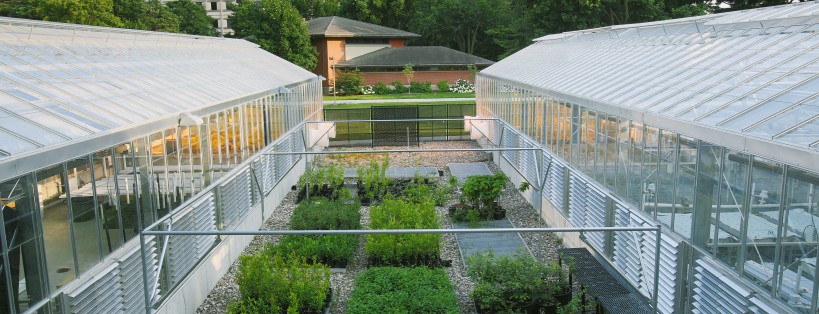History
By Charles V. Hall
Emeritus Professor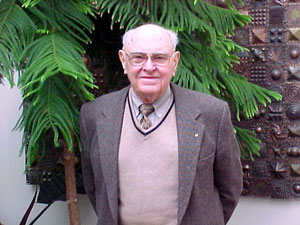
1836-1975
The roots of horticulture extend back to the years before Iowa became a state. The early immigrants who came from eastern states were eager to grow fruits, vegetables, trees, and nursery crops. The person who had the greatest impact on the future of agriculture and horticulture in Iowa was Suel Foster.
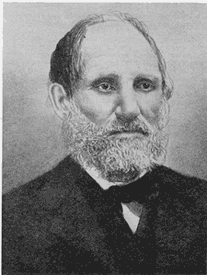 Suel Foster came to Bloomington (now Muscatine) in 1836. After getting married and making a trip to California he returned to Bloomington and established the Fountain Hill Nursery of over 100 acres. In 1856, as writer for the Iowa Farmer and Horticulturist he took up the subject of schooling for farmers. He insisted that Iowa must have a Farmers College. Following the publication of this proposal 4 more times, in January 1858 the Iowa Legislature (General Assembly) passed an act to establish an Iowa Agricultural College which was signed by Governor Ralph Lowe on March 22, and appropriated $10,000 for support. Suel Foster was appointed to the first Board of Trustees and the Charter which was developed included the requirement that horticulture be taught. A site for the college was selected in a prairie west of Ames. When the Morrill Act, the Land Grant College Act, was passed July 2, 1862 and on September 11, 1862 Iowa was the first state to accept provisions of the act and received a grant of over 294,300 acres of Government land.
Suel Foster came to Bloomington (now Muscatine) in 1836. After getting married and making a trip to California he returned to Bloomington and established the Fountain Hill Nursery of over 100 acres. In 1856, as writer for the Iowa Farmer and Horticulturist he took up the subject of schooling for farmers. He insisted that Iowa must have a Farmers College. Following the publication of this proposal 4 more times, in January 1858 the Iowa Legislature (General Assembly) passed an act to establish an Iowa Agricultural College which was signed by Governor Ralph Lowe on March 22, and appropriated $10,000 for support. Suel Foster was appointed to the first Board of Trustees and the Charter which was developed included the requirement that horticulture be taught. A site for the college was selected in a prairie west of Ames. When the Morrill Act, the Land Grant College Act, was passed July 2, 1862 and on September 11, 1862 Iowa was the first state to accept provisions of the act and received a grant of over 294,300 acres of Government land.
Prior to acceptance of the Morrill Act the State of Iowa, citizens of Boone and Story Counties provided $5,379 for the purchase of 648 acres of land from 5 owners for the campus and experimental farm. The site chosen was where the current campus is located, which at that time was prairie. In 1860 and 61 the Farm House, which stands on the campus today as a historic building, was constructed. The cattle barn was constructed the same year and was torn down in 1929. In 1866 an experimental orchard was planted consisting of 400 fruit trees, 75 grape vines, along with 1/2 acre of potatoes, 3/4 acre of root crops, 1/2 acre of beans and an ornamental garden containing trees, shrubs and flowers. The population of Ames was less than 1000 at that time.
On June 26, 1866 the Iowa State Horticultural Society was formed which boosted the expansion of research and support for horticulture in the state. At that time the society served as a communication link between the college and horticultural producers throughout the state.
 In 1868, following the close of the Civil War, Old Main was completed with no provisions for heat light and furnishings. In spite of the lack of these essentials, the Iowa Agricultural College and Farm opened for preparatory students October 21, 1868 with the first term ending January 7, 1869. Students lived, ate and attended classes in this one building. Old Main burned in 1900 at the site where Beardshear Hall now stands.
In 1868, following the close of the Civil War, Old Main was completed with no provisions for heat light and furnishings. In spite of the lack of these essentials, the Iowa Agricultural College and Farm opened for preparatory students October 21, 1868 with the first term ending January 7, 1869. Students lived, ate and attended classes in this one building. Old Main burned in 1900 at the site where Beardshear Hall now stands.
The first horticulture classes were taught beginning October 21, 1869 with Dr. Norton S. Townsend as Professor of Agriculture and Horticulture and A.S. Welch (see Appendix for a complete listing of all faculties) as Lecturer of Landscape Gardening and Charles Bessey teaching Horticulture and Botany. In 1869 horticultural subjects were taught when a total of only 20 subjects were offered in the college. The total student body consisted of 75, 66 men and 9 women. Professor Towsend taught a course in practical agriculture too. The first faculty consisted of 4 professors, a matron and teacher of music, French, and German and a farm Superintendent. A major change came with the inauguration of A.S. Welch as College President that same year with a salary of $3,000 per year with a house. He taught a course in Landscape Gardening and was overseer of campus design and planting.
Professor Charles Bessey was hired to teach horticulture and Botany and James Matthews was hired as professor of pomology and the first Head of Horticulture. 1873 H.H. McAfee became Department Head replacing Matthews. That same year Wesley Green graduated as the first student specializing in horticulture. Following graduation he enrolled in Law School at the University of Iowa after 2 years. During his career he taught school 5 years, 20 years growing fruits, vegetables and floriculture in the tri-cities area, as Secretary of the Iowa Horticultural Society, and State Forestry Commissioner for 11 years.
1875-1910
In 1877 J.L. Budd was hired as Professor of Horticulture and Forestry and Department the year the department was officially named as the first official department in agriculture. Professor Budd became recognized as the outstanding teacher of Horticulture in the northern plains and the US. Upon Professor Budds’death in 1905, Liberty Hyde Bailey said “that it ended the first epoch in the teaching of Horticulture in the country”. He was recognized as one of if not the greatest horticultural teachers in the US. Also, he developed one of the largest fruit breeding programs in the country, with major emphasis on apples. The greatest problem with fruit growing in Iowa was lack of winter hardiness. Other minor crops were plums, pears and cherries. Prof. Budd served as Secretary of the Iowa Horticultural Society from 1873-1885 and from 1892-1895.
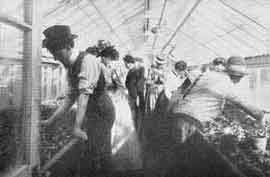 In 1878 Prof. Budd was able to import 200 varieties 0f apples, some plums and cherries from Russia. In 1882 he and Charles Gibbs from Quebec, Canada visited England, Russia and other European countries where they collected over 100 varieties of apple, cherries, pears, and ornamentals. The apples were propagated, distributed to growers, and turned out to be a major embarrassment since they matured in late summer and would not store. In addition, the apples were very susceptible to diseases. However, they became very valuable germ plasm sources in breeding for winter hardiness. Professor Budd and others were successful in breeding a number of varieties, which were adapted to the plains states.
In 1878 Prof. Budd was able to import 200 varieties 0f apples, some plums and cherries from Russia. In 1882 he and Charles Gibbs from Quebec, Canada visited England, Russia and other European countries where they collected over 100 varieties of apple, cherries, pears, and ornamentals. The apples were propagated, distributed to growers, and turned out to be a major embarrassment since they matured in late summer and would not store. In addition, the apples were very susceptible to diseases. However, they became very valuable germ plasm sources in breeding for winter hardiness. Professor Budd and others were successful in breeding a number of varieties, which were adapted to the plains states.
Some of Budd’s students distinguished themselves as faculty members at various institutions. John Craig 0f Quebec, Canada after graduating from Iowa State returned to Canada as Dominion Horticulturist at Ottawa and in 1889 returned to Iowa State to replace Budd as Department Head. Later he went to Cornell University as Department Head. Others who became horticultural leaders were Charles A. Keiffer who received an MS degree in 1887 and went to South Dakota as Department Head and later moved to Missouri as department head. N. E. Hansen graduated with a BS degree in 1887 and an MS degree in 1895, moved to South Dakota and where he became an internationally known plant explorer and plant breeder. These are only a few of his students. They came from all over the state and country to study with Prof. Budd. Probably the most recognized of his students was S. A. Beach who will be discussed later.
For over 25 years he wrote a weekly article for the Des Moines Register. In 1884-85 Budd served as Acting President of the College.
Prof. Budd’s daughter Etta was teaching at Simpson College at Indianola when George Washington Carver came there as a student. Since he was more interested in agriculture than art she convinced him to come to Iowa State. Upon arrival here he lived with her dad and mother. He later became manager of the greenhouses and according to Department of Horticulture records received his degree in 1885. The first MS degree in Horticulture was awarded in 1883.
 The first BS degree as a Horticulture Major was approved in 1904 and the first 2 graduates in the major were W.C. Claybaugh and Arthur J. Secor.
The first BS degree as a Horticulture Major was approved in 1904 and the first 2 graduates in the major were W.C. Claybaugh and Arthur J. Secor.
The Horticulture Club was organized in 1900 as the first agricultual departmental club, which included forestry and landscape design. The first Forestry Club was formed in 1905. In 1917 the landscape design student formed a separate club called the Vistonians.
1875-1940
A. T. Erwin , a graduate of the University of Arkansas, filled in as Interim Head until S. A. Beach returned as Department Head in 1905 after having served at the Agricultural Experiment Station at Geneva New York from1891-1905. He had received a BS degree in 1887 and an MS degree from Iowa State in 1892. He was named to the ASHS Hall of Fame in 1993 in recognition for his outstanding achievements at Geneva and Iowa State. Among his greatest achievements was the founding of the American Society for Horticultural Science in cooperation with Liberty Hyde Bailey with the first meeting being held in 1903.
A. T. Erwin came to Iowa State from the Missouri Botanical Garden where he taught general horticulture, forestry, and landscape gardening. He was promoted to full professor in 1905.He headed the vegetable research until he retired in 1940. He was a charter member of ASHS, served as president in 1930, and was honored as the oldest living member in 1969. Erwin was recognized for the systematic classification of many vegetable crops, especially the cucurbits. He had a broad knowledge of all horticultural crops.
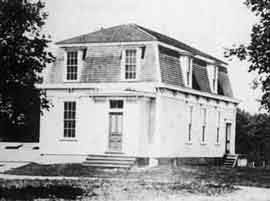 The department made tremendous growth during Beachs’ tenure as department head. In 1880 the first horticulture building was constructed where the Parks Library now stands. During most of the first century there was rapid turnover of faculty in the department. The department moved into Agricultural Hall (Old Botany) in 1893 and the horticulture building became the Faculty Club. In 1905 they moved into the newly constructed Horticulture Lab. located East of Ag. Hall. (This building was torn down in 1978 and replaced by the current Horticulture Building). By 1922 when Prof. Beach died,the department had 24 faculty members that included Forestry and Landscape Architecture. Only Cornell and the University of California departments were larger. During his regime the department granted 74 BS degrees (excluding forestry), 26 MS degrees, and at least 1 Phd. Incidentally, in 1906 when extension was formed, horticulture was 1 of 6 subjects to be included and in 1913 when the graduate division was formed, horticulture was 1 of 8 disciplines to be approved for the Ph.D. degree.
The department made tremendous growth during Beachs’ tenure as department head. In 1880 the first horticulture building was constructed where the Parks Library now stands. During most of the first century there was rapid turnover of faculty in the department. The department moved into Agricultural Hall (Old Botany) in 1893 and the horticulture building became the Faculty Club. In 1905 they moved into the newly constructed Horticulture Lab. located East of Ag. Hall. (This building was torn down in 1978 and replaced by the current Horticulture Building). By 1922 when Prof. Beach died,the department had 24 faculty members that included Forestry and Landscape Architecture. Only Cornell and the University of California departments were larger. During his regime the department granted 74 BS degrees (excluding forestry), 26 MS degrees, and at least 1 Phd. Incidentally, in 1906 when extension was formed, horticulture was 1 of 6 subjects to be included and in 1913 when the graduate division was formed, horticulture was 1 of 8 disciplines to be approved for the Ph.D. degree.
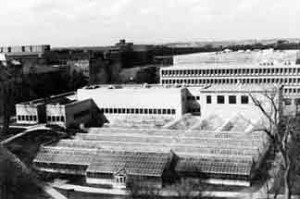 The greenhouse range constructed in 1913 exists today connected to the headhouse structure, which was completed in 1915 providing laboratory and office space for the existing faculty except for the departmental office. Dr. Haber, Department , Head, moved from Curtiss Hall to the building in 1945. The greenhouse range constructed in 1913 was 27,000 square feet and 3750 square feet was added and opened in 1980 as a part of the new facility. For a slide sequence illustrating construction of the building and greenhouse addition, click here.
The greenhouse range constructed in 1913 exists today connected to the headhouse structure, which was completed in 1915 providing laboratory and office space for the existing faculty except for the departmental office. Dr. Haber, Department , Head, moved from Curtiss Hall to the building in 1945. The greenhouse range constructed in 1913 was 27,000 square feet and 3750 square feet was added and opened in 1980 as a part of the new facility. For a slide sequence illustrating construction of the building and greenhouse addition, click here.
During the 17 years Beach was head faculty were hired in forestry, floriculture, landscape architecture, pomology and vegetable crops. Two extension specialists became nationally known for their work, R. S. Herrick (pomology) and C. L. Fitch (vegetable crops).By 1922 ,7 were listed on the extension staff. Professor Volz made a major contribution by establishing the floriculture teaching, research and ornamental garden programs at the college. He established the campus formal gardens that have been continuous throughout the 20th Century. Also, he initiated the floriculture and garden flower breeding programs which has yielded many new varieties. In addition to Prof. Beach,s leadership as department head he was a very prominent fruit breeder. During his tenure at Iowa State he released 1 peach and 10 apple varieties. Because of his outstanding national recognition as a horticultural leader he was named to the ASHS Hall of fame in 1993.
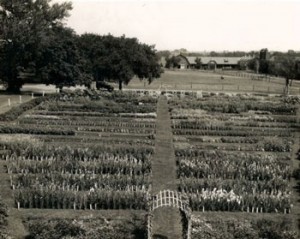
Horticulture Gardens in 1922 (where Bessey Hall now stands)
In 1920-21 the General Catalog lists the Department of Horticulture and Forestry with the description, “This department includes these major lines of work: Floriculture, Forestry, Landscape Architecture, Pomology, and General Horticulture, Truck Crops and Market Gardening.”
The first Ph.D was granted to E. H. Haber in 1923. After serving for a number of years on the faculty he was appointed department head in 1940.
In 1922 Dr. Linstrom moved from Horticulture and established a Genetics Department. Also, in 1922 220 acres was purchased southwest of the campus for fruit research on which structures were built for handling and storage. The previous site was north of the campus from 1886 to 1924 in the area that encompassed Pammel Courts and the Veenker Golf Course. Currently this area is occupied by the outdoor athletic facilities. The present Veenker Golf Course was constructed in 1938 with WPA and Athletic Department funds at a cost of $122,373.
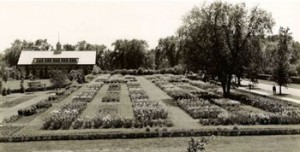
Trial Gardens 1949 (present site of Agronomy Building)
A prominent name at ISU is J. C. Schilleter. He was appointed to the faculty of Horticulture in 1923 and is currently living in Ames. In 1942 he left Horticulture to take charge of university housing during WWII and the Memorial Union. He was responsible for acquiring and building Pammel Court after the war. Today Schilleter Village stands as a tribute to Prof. Schilleter.
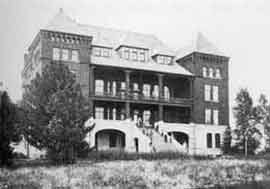
Professor B. S. Pickett came to Iowa State College in 1923 as Head of the Department of Horticulture and Forestry to succeed Prof. Beach. He had served as Head of the Department of Horticulture and Forestry at the University of New Hampshire from 1908-1912. Building upon the strong foundation established by Budd, Erwin and Beach he made tremendous strides in the development of a strong teaching, research and extension programs along with support facilities. During his tenure from 1923-47 the department awarded 136 BS , 65 MS and 22 Ph.D degrees, excluding Forestry. Professor Pickett was in many state and national organizations. He served as President of the American Pomological Society from 1932 to 1941, and President of the American Apple Institute from 1935-36.
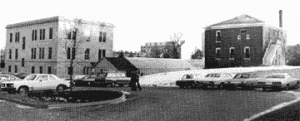 During his administration 2 new departments were formed out of the Department of Horticulture. In 1930 Landscape Design became a separate department and in 1940 and Department of Forestry was established. However, the department remained strong and continued to expand in the basic programs of pomology, vegetable crops, floriculture, ornamentals and herbaceous ornamental gardening. The Federated Garden Clubs was established in 1928 and the Greenskeepers (currently Golf Course Superindents Association) in 1921.
During his administration 2 new departments were formed out of the Department of Horticulture. In 1930 Landscape Design became a separate department and in 1940 and Department of Forestry was established. However, the department remained strong and continued to expand in the basic programs of pomology, vegetable crops, floriculture, ornamentals and herbaceous ornamental gardening. The Federated Garden Clubs was established in 1928 and the Greenskeepers (currently Golf Course Superindents Association) in 1921.
1940-2000
In 1947 E. S. Haber became Department Head after having served in the department as a staff and faculty member since 1920. He had been and continued to be a very productive in research and teaching. His greatest achievement was in sweetcorn breeding, genetics, and physiological studies. In 1938 he published research results of Drought Resistance in Inbred Sweetcorn Lines. This was many years before the idea of stress physiology became popular. He was the pioneer in the development of hybrid sweetcorn and his inbred lines are still used today in the commercial hybrids. He was involved in breeding and research with other vegetables. He served as President of the Sweetcorn Breeders of America in 1953-54 and President of the American Society for Horticultural Science in 1954-55. During his tenure as department head 118 BS, 15 Ms and 12 pH degrees were awarded. As a tribute to his productivy and leadership the Iowa Nurserymen’s Association established the E. S. Haber Scholarship which continues today. He died in 1961.
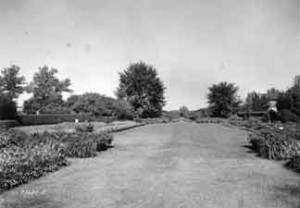 The Department of Horticulture at Iowa State was a national leader in the education, research and extension programs up through Dr. Haber’s tenure. Plant breeding programs of Professors Budd, Beach, Erwin, Pickett, Volz, and Haber, 50 horticultural varieties were named and released. Theses consisted of 16 fruit, 10 ornamental and 34 vegetables. A number of these are still in existence today.
The Department of Horticulture at Iowa State was a national leader in the education, research and extension programs up through Dr. Haber’s tenure. Plant breeding programs of Professors Budd, Beach, Erwin, Pickett, Volz, and Haber, 50 horticultural varieties were named and released. Theses consisted of 16 fruit, 10 ornamental and 34 vegetables. A number of these are still in existence today.
Other prominent names who were major contributors to Iowa state horticulture prior to and during WW II were: T. J. Maney, C. L. Fitch, E. C. Volz, H. W. Richey, H. L. Lantz, H. E. Nichols, V. T. Stoutemeyer, and P. A. MInges.
In 1947 Lewis Peterson was hired as manager of the Muscatine vegetable experiment station. He remained in that role until 1980 where he became the leader of southeast Iowa commercial vegetable industry. Also, he developed the watermelon variety Iopride.
A.E. Cott was appointed as extension fruit specialist but before his retirement in 1980 he had become well known as extension leader in floriculture, nursery crops and turf management. Ed was known by most horticulturists in Iowa before his retirement. He had become the chief liaison extension person with the Iowa Horticultural Society.
Ben Vance was a long time extension specialist for vegetables and worked with the Federation Garden Clubs from 1952 to 1975.
Ed Lana was the vegetable specialist in production and breeding from 1956 to 1997.
Other faculty who made major contributions to horticulture at Iowa State and the industries vegetable crops, nursery mgt. Turfgrass culture and golf course mgt. Were A. E. Kehr, Donald White Lincoln Pierce, and Elliott Roberts. Many other names appear on the total faculty list and only a few have been highlighted. One famous name among others was Professor Harry Nichols who was extension fruit specialist and department historian. Much of this early history was preserved by prof. Nichols during his tenure from 1918 and 1980.
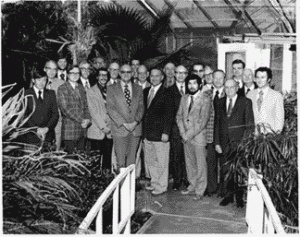 J. P. Mahlstede who had joined the faculty in 1952 specializing in ornamentals and nursery management was named department head in 1961 succeeding E. S. Haber serving until 1965 when he became Associate Director of the Agricultural Experiment Station. During his tenure in the department he and Dr. Haber jointly authored a textbook Plant Propagation that was widely used for a number of years. During that time the department was rebuilding following WW II. Like most institutions there was a large influx of veteran students following the war and by this time many continued in graduate school. Between 1940-48 3 USDA specialists were assigned to the department. In 1949 E. L. Denisen resumed the fruit breeding work but much of the other research was directed toward culture and management. By this time the fruit and vegetable industries in Iowa had diminished a great deal. The nursery, floriculture and turf industries were stable or growing. The undergraduate student enrollment had decreased to 27 in 1960. The teaching research faculty numbered only7 with 5in extension or with joint appointments.During the period between 1956-66 11 faculty were hired of which only 5 remained in 1966. This was a period of transition for many new faculty members. Also, the department facilities, equipment and financial support were inadequate to encourage new faculty. Dr. Denisen’s small fruit breeding work resulted in the release of Black Hawk and Liberty raspberries, Stoplight and Cyclone strawberries and a number of improved cultural production methods.
J. P. Mahlstede who had joined the faculty in 1952 specializing in ornamentals and nursery management was named department head in 1961 succeeding E. S. Haber serving until 1965 when he became Associate Director of the Agricultural Experiment Station. During his tenure in the department he and Dr. Haber jointly authored a textbook Plant Propagation that was widely used for a number of years. During that time the department was rebuilding following WW II. Like most institutions there was a large influx of veteran students following the war and by this time many continued in graduate school. Between 1940-48 3 USDA specialists were assigned to the department. In 1949 E. L. Denisen resumed the fruit breeding work but much of the other research was directed toward culture and management. By this time the fruit and vegetable industries in Iowa had diminished a great deal. The nursery, floriculture and turf industries were stable or growing. The undergraduate student enrollment had decreased to 27 in 1960. The teaching research faculty numbered only7 with 5in extension or with joint appointments.During the period between 1956-66 11 faculty were hired of which only 5 remained in 1966. This was a period of transition for many new faculty members. Also, the department facilities, equipment and financial support were inadequate to encourage new faculty. Dr. Denisen’s small fruit breeding work resulted in the release of Black Hawk and Liberty raspberries, Stoplight and Cyclone strawberries and a number of improved cultural production methods.
Dr. G.J. Buck was added to the faculty in 1952 to resume the teaching, research and ornamental breeding programs of Pro. Volz His work consisted of the development of very successful breeding programs with roses and geraniums. He released a number of varieties of roses of which Carefree Beauty is commercially popular and complete collections are exhibited at Rieman Gardens and the Iowa Arboretum. Also, his Geranium varieties are in widespread commercial use. Up to 1960 the department awarded 332 BS, 110 MS and 34 Ph.D degrees. Many of these graduates went on to become professionals in education and business throughout the country.

